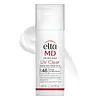What's inside
What's inside
 Key Ingredients
Key Ingredients

 Benefits
Benefits

 Concerns
Concerns

 Ingredients Side-by-side
Ingredients Side-by-side

Water
Skin ConditioningCaprylic/Capric Triglyceride
MaskingC12-15 Alkyl Benzoate
AntimicrobialTitanium Dioxide
Cosmetic ColorantZinc Oxide
Cosmetic ColorantEthylhexyl Methoxycrylene
Skin ConditioningGlycerin
HumectantPolyester-8
Skin ConditioningAluminum Stearate
Cosmetic ColorantC15-19 Alkane
SolventHydrogenated Lecithin
EmulsifyingSilica
AbrasiveTrehalose
HumectantInulin
Skin ConditioningAlpha-Glucan Oligosaccharide
CleansingAscorbyl Palmitate
AntioxidantTocopherol
AntioxidantEchium Plantagineum Seed Oil
Skin ConditioningHelianthus Annuus Seed Oil
EmollientSimmondsia Chinensis Seed Oil
EmollientCentella Asiatica Extract
CleansingPolyhydroxystearic Acid
EmulsifyingAlumina
AbrasiveGlyceryl Caprylate
EmollientHydroxyethyl Acrylate/Sodium Acryloyldimethyl Taurate Copolymer
Emulsion StabilisingLeuconostoc/Radish Root Ferment Filtrate
AntimicrobialAmmonium Acryloyldimethyltaurate/Vp Copolymer
Caprylhydroxamic Acid
Triethoxycaprylylsilane
Diheptyl Succinate
EmollientXanthan Gum
EmulsifyingAllantoin
Skin ConditioningSodium Polyacrylate
AbsorbentSodium Hydroxide
BufferingAcacia Senegal Gum
MaskingSodium Citrate
BufferingCapryloyl Glycerin/Sebacic Acid Copolymer
Skin ConditioningPolysorbate 60
EmulsifyingSorbitan Isostearate
EmulsifyingGlyceryl Stearate
EmollientLecithin
EmollientGlyceryl Oleate
EmollientCitric Acid
BufferingSodium Benzoate
MaskingWater, Caprylic/Capric Triglyceride, C12-15 Alkyl Benzoate, Titanium Dioxide, Zinc Oxide, Ethylhexyl Methoxycrylene, Glycerin, Polyester-8, Aluminum Stearate, C15-19 Alkane, Hydrogenated Lecithin, Silica, Trehalose, Inulin, Alpha-Glucan Oligosaccharide, Ascorbyl Palmitate, Tocopherol, Echium Plantagineum Seed Oil, Helianthus Annuus Seed Oil, Simmondsia Chinensis Seed Oil, Centella Asiatica Extract, Polyhydroxystearic Acid, Alumina, Glyceryl Caprylate, Hydroxyethyl Acrylate/Sodium Acryloyldimethyl Taurate Copolymer, Leuconostoc/Radish Root Ferment Filtrate, Ammonium Acryloyldimethyltaurate/Vp Copolymer, Caprylhydroxamic Acid, Triethoxycaprylylsilane, Diheptyl Succinate, Xanthan Gum, Allantoin, Sodium Polyacrylate, Sodium Hydroxide, Acacia Senegal Gum, Sodium Citrate, Capryloyl Glycerin/Sebacic Acid Copolymer, Polysorbate 60, Sorbitan Isostearate, Glyceryl Stearate, Lecithin, Glyceryl Oleate, Citric Acid, Sodium Benzoate
Zinc Oxide 9%
Cosmetic ColorantEthylhexyl Methoxycinnamate 7.5%
UV AbsorberWater
Skin ConditioningCyclopentasiloxane
EmollientNiacinamide
SmoothingOctyldodecyl Neopentanoate
EmollientHydroxyethyl Acrylate/Sodium Acryloyldimethyl Taurate Copolymer
Emulsion StabilisingButylene Glycol
HumectantPhenoxyethanol
PreservativePolyisobutene
Triethoxycaprylylsilane
Tocopheryl Acetate
AntioxidantPEG-7 Trimethylolpropane Coconut Ether
EmulsifyingOleth-3 Phosphate
Iodopropynyl Butylcarbamate
PreservativeLactic Acid
BufferingSodium Hyaluronate
HumectantPhosphoric Acid
BufferingZinc Oxide 9%, Ethylhexyl Methoxycinnamate 7.5%, Water, Cyclopentasiloxane, Niacinamide, Octyldodecyl Neopentanoate, Hydroxyethyl Acrylate/Sodium Acryloyldimethyl Taurate Copolymer, Butylene Glycol, Phenoxyethanol, Polyisobutene, Triethoxycaprylylsilane, Tocopheryl Acetate, PEG-7 Trimethylolpropane Coconut Ether, Oleth-3 Phosphate, Iodopropynyl Butylcarbamate, Lactic Acid, Sodium Hyaluronate, Phosphoric Acid
 Reviews
Reviews

Ingredients Explained
These ingredients are found in both products.
Ingredients higher up in an ingredient list are typically present in a larger amount.
This is a synthetic polymer. It helps improve the texture of products by adding thickness and gel-like feel.
It is also an emulsifer, meaning it prevents ingredients such as oil and water from separating. It also helps evenly disperse other ingredients.
Triethoxycaprylylsilane is a silicone used to bind and stabilize ingredients.
As an emulsifier, it helps prevent ingredients from separating. This can help elongate the shelf life of products.
Triethoxycaprylylsilane is often used to coat mineral sunscreens ingredients to help give a better feel. It also helps reduce oxidative stress in sunscreens.
Learn more about TriethoxycaprylylsilaneWater. It's the most common cosmetic ingredient of all. You'll usually see it at the top of ingredient lists, meaning that it makes up the largest part of the product.
So why is it so popular? Water most often acts as a solvent - this means that it helps dissolve other ingredients into the formulation.
You'll also recognize water as that liquid we all need to stay alive. If you see this, drink a glass of water. Stay hydrated!
Learn more about WaterZinc Oxide is a mineral broad-spectrum UV filter; it is the broadest UVA and UVB reflector approved by the FDA. It also has skin protectant and skin soothing properties.
Zinc oxide is one of the most effective broad-spectrum UV filters. It protects against UVB, UVAII, and UVAI. In comparison to its counterpart titanium dioxide, zinc oxide provides uniform and extended UVA protection.
Another great benefit? This ingredient is highly photostable so it won't degrade easily under sunlight.
A common myth is that mineral UV filters are widely believed to primarily reflect UV light.
However, modern research shows titanium dioxide absorbs UV radiation like chemical filters (~95% absorption & 5% reflection).
Zinc oxide has great skin soothing properties so you'll likely find this in sunscreens formulated for sensitive skin or babies/children. It is unlikely to cause "eye sting" like other sunscreen ingredients.
Regulatory agencies consider zinc oxide to be non-toxic and safe. It has also been shown to not penetrate the skin.
Unfortunately, this ingredient does leave a visible white cast. This is why mineral sunscreens are often less cosmetically elegant than chemical or hybrid ones.
In cosmetics, zinc oxide can be found in both non-nano and nano-sized forms. The nano version is used to reduce white cast and improve the texture of sunscreen formulas.
There are ongoing concerns surrounding nano-zinc oxide's impact on marine ecosystems and whether it can be absorbed into skin.
Regarding marine ecosystems and coral reefs, there is no conclusive evidence that any form of zinc oxide (or any other sunscreen ingredients) will cause harm. The science is still developing but many consumers are keeping a close eye on this issue.
Please note, many destinations have reef-safety sunscreen rules. For instance, the U.S. Virgin Islands advises all visitors to use non-nano mineral sunscreens.
There has also been some stir about whether micronized or nano zinc oxide has potential photoxicity and absorption through the skin/lungs.
An in-vitro (done in a test tube or petri dish) study demonstrated micronized zinc oxide to have potential phototoxicity. There's no need to fret; the EU Commission's Scientific Committee on Consumer Safety has stated, "The relevance of these findings needs to be clarified by appropriate investigations in vivo." Or in other words, further studies done on living organisms are needed to prove this.
Current research shows zinc oxide nanoparticles do not penetrate intact or sunburned skin. They either remain on the surface or in the outermost layer of dead skin (stratum corneum).
Zinc oxide is one of only two classified mineral UV filters with titanium dioxide being the other one.
Fun fact: Zinc has been used throughout history as an ingredient in paint and medicine. An Indian text from 500BC is believed to list zinc oxide as a salve for open wound. The Ancient Greek physician Dioscorides has also mentioned the use of zinc as an ointment in 1AD.
Learn more about Zinc Oxide